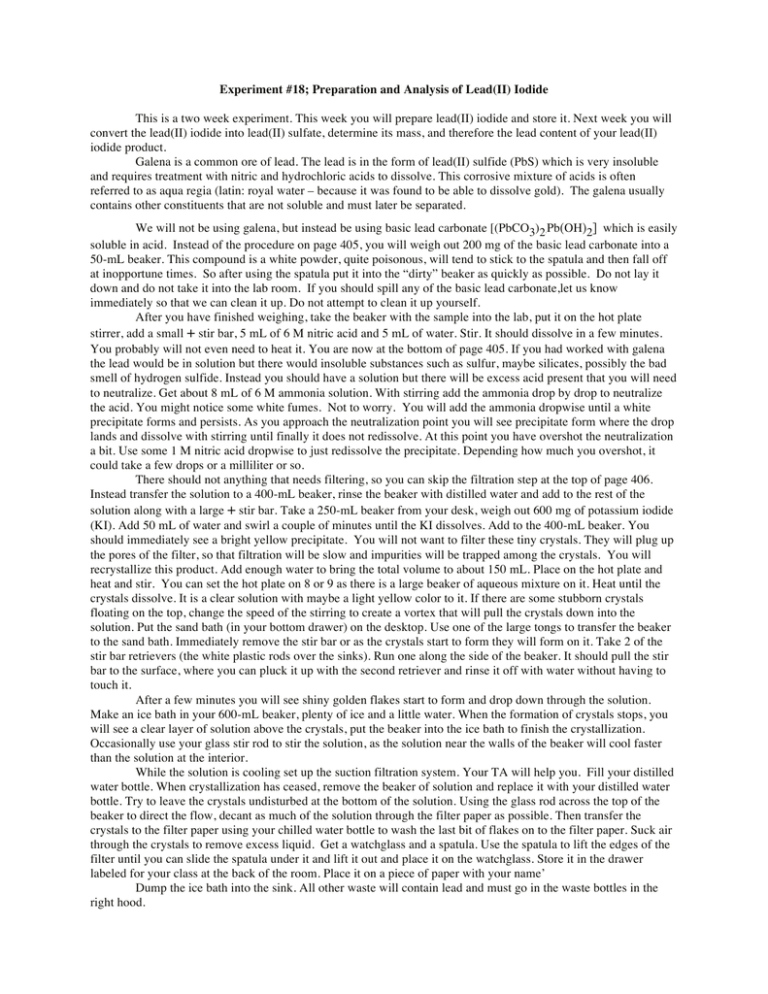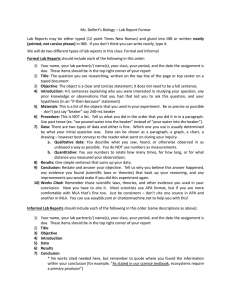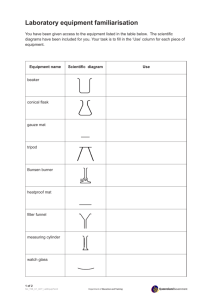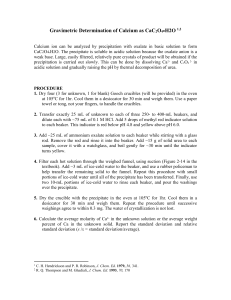Experiment #18; Preparation and Analysis of Lead(II) Iodide
advertisement

Experiment #18; Preparation and Analysis of Lead(II) Iodide This is a two week experiment. This week you will prepare lead(II) iodide and store it. Next week you will convert the lead(II) iodide into lead(II) sulfate, determine its mass, and therefore the lead content of your lead(II) iodide product. Galena is a common ore of lead. The lead is in the form of lead(II) sulfide (PbS) which is very insoluble and requires treatment with nitric and hydrochloric acids to dissolve. This corrosive mixture of acids is often referred to as aqua regia (latin: royal water – because it was found to be able to dissolve gold). The galena usually contains other constituents that are not soluble and must later be separated. We will not be using galena, but instead be using basic lead carbonate [(PbCO3)2.Pb(ΟΗ)2] which is easily soluble in acid. Instead of the procedure on page 405, you will weigh out 200 mg of the basic lead carbonate into a 50-mL beaker. This compound is a white powder, quite poisonous, will tend to stick to the spatula and then fall off at inopportune times. So after using the spatula put it into the “dirty” beaker as quickly as possible. Do not lay it down and do not take it into the lab room. If you should spill any of the basic lead carbonate,let us know immediately so that we can clean it up. Do not attempt to clean it up yourself. After you have finished weighing, take the beaker with the sample into the lab, put it on the hot plate stirrer, add a small + stir bar, 5 mL of 6 M nitric acid and 5 mL of water. Stir. It should dissolve in a few minutes. You probably will not even need to heat it. You are now at the bottom of page 405. If you had worked with galena the lead would be in solution but there would insoluble substances such as sulfur, maybe silicates, possibly the bad smell of hydrogen sulfide. Instead you should have a solution but there will be excess acid present that you will need to neutralize. Get about 8 mL of 6 M ammonia solution. With stirring add the ammonia drop by drop to neutralize the acid. You might notice some white fumes. Not to worry. You will add the ammonia dropwise until a white precipitate forms and persists. As you approach the neutralization point you will see precipitate form where the drop lands and dissolve with stirring until finally it does not redissolve. At this point you have overshot the neutralization a bit. Use some 1 M nitric acid dropwise to just redissolve the precipitate. Depending how much you overshot, it could take a few drops or a milliliter or so. There should not anything that needs filtering, so you can skip the filtration step at the top of page 406. Instead transfer the solution to a 400-mL beaker, rinse the beaker with distilled water and add to the rest of the solution along with a large + stir bar. Take a 250-mL beaker from your desk, weigh out 600 mg of potassium iodide (KI). Add 50 mL of water and swirl a couple of minutes until the KI dissolves. Add to the 400-mL beaker. You should immediately see a bright yellow precipitate. You will not want to filter these tiny crystals. They will plug up the pores of the filter, so that filtration will be slow and impurities will be trapped among the crystals. You will recrystallize this product. Add enough water to bring the total volume to about 150 mL. Place on the hot plate and heat and stir. You can set the hot plate on 8 or 9 as there is a large beaker of aqueous mixture on it. Heat until the crystals dissolve. It is a clear solution with maybe a light yellow color to it. If there are some stubborn crystals floating on the top, change the speed of the stirring to create a vortex that will pull the crystals down into the solution. Put the sand bath (in your bottom drawer) on the desktop. Use one of the large tongs to transfer the beaker to the sand bath. Immediately remove the stir bar or as the crystals start to form they will form on it. Take 2 of the stir bar retrievers (the white plastic rods over the sinks). Run one along the side of the beaker. It should pull the stir bar to the surface, where you can pluck it up with the second retriever and rinse it off with water without having to touch it. After a few minutes you will see shiny golden flakes start to form and drop down through the solution. Make an ice bath in your 600-mL beaker, plenty of ice and a little water. When the formation of crystals stops, you will see a clear layer of solution above the crystals, put the beaker into the ice bath to finish the crystallization. Occasionally use your glass stir rod to stir the solution, as the solution near the walls of the beaker will cool faster than the solution at the interior. While the solution is cooling set up the suction filtration system. Your TA will help you. Fill your distilled water bottle. When crystallization has ceased, remove the beaker of solution and replace it with your distilled water bottle. Try to leave the crystals undisturbed at the bottom of the solution. Using the glass rod across the top of the beaker to direct the flow, decant as much of the solution through the filter paper as possible. Then transfer the crystals to the filter paper using your chilled water bottle to wash the last bit of flakes on to the filter paper. Suck air through the crystals to remove excess liquid. Get a watchglass and a spatula. Use the spatula to lift the edges of the filter until you can slide the spatula under it and lift it out and place it on the watchglass. Store it in the drawer labeled for your class at the back of the room. Place it on a piece of paper with your name’ Dump the ice bath into the sink. All other waste will contain lead and must go in the waste bottles in the right hood.





